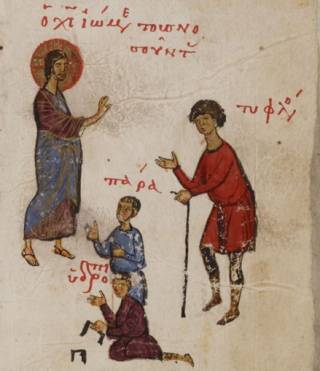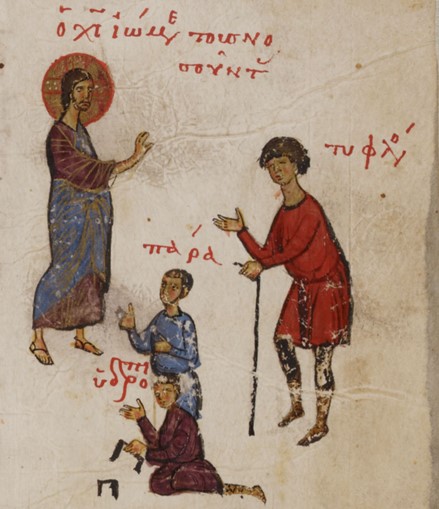These are some of the aspects a group of 15 scholars from around the world have discussed during the workshop Constructing and performing hope in the premodern world, which took place in Tampere on the second week of April (13th-14th). The workshop, which will result in a collective volume, was organized together with another Trivium member, Ville Vuolanto, as part of my ongoing research project at the Tampere Institute for Advanced Studies entitled Hope springs eternal: Constructing hope and meaningful life in Medieval Byzantium.
The project explores the ways in which the Byzantine families navigated personal crises related to children via hope, understood as a social and emotional practice, which has a central place in the strategies people built for the future and meaningful life.
A miracle story included in the Translation and Miracles of St. Theodora of Thessalonike (ninth century) illustrates such a family crisis many Byzantine parents had to cope with, and some ways in which people acted out in such circumstances. Theodotos, one of the disciples of St. Theodora and an active promoter of her cult, had been married to a noble woman for almost fifteen years. During this time, they became the parents of four children who died in a row after reaching the age of two or three. All human assistance was useless and despairing of the situation, Theodotos decided to put all his hopes in divinity by vowing that if they were to have another child, they would entrust her to God. After some time, his wife gave birth to a girl, but when she was one year old, a severe illness put the baby’s life in danger. Theodotos rushed to St. Theodora’s tomb and prayed ardently for the child’s healing, promising that she will be immediately dedicated to monastic life in exchange for her recovery. When the little one recovered, he kept his promise and entrusted her to the convent of the saint. However, in the following year, the girl fell ill again and because she was in a critical condition, everybody expected her to die.
In an emotional prayer addressed to St. Theodora, the hagiographer imagined how Theodotos invoked the saint desperately for another miracle while stressing how much he had hoped for this child to survive: ‘Mother, why do you not heed the sound of my wailing? … For death is trying like a lion to snatch away the child that I hoped to have through your intercessions, now that she is growing up. Why do you not entreat the merciful Christ our God on her behalf to grant her to you to be a source of joy and pride for those who have faithfully placed their hope in you?’ The story had a happy end – the girl survived, and her case was included in the list of miracles performed by St. Theodora as a proof of the healing powers of the saint which would in turn lead to the promotion of her cult.
Hope appears at the core of emotional practices which are constituted by the actions taken by the parents. It is precisely these moments of uncertainty that underlie the practices of hope. The hero of our story first hoped that his children would survive the risky years of infancy, but after all human help proved to be in vain, when everything seemed to fall apart with his children dying one by one, he and his wife decided to put their hopes in God.
In Byzantium, as in all premodern societies, infancy was one of the most vulnerable periods of life when the risk of death was extremely high due to the dangers associated with weaning. Most likely, as was the case with many well-off Byzantines, Theodotos first appealed to the help of doctors, but when things went astray and the medicine proved its limits, the only hope left for him was in divine assistance. This is a well-known topos in miracle narratives meant to show the healing powers that God endowed his saints with, as well as the severity of the situation.
Once another child was born, a strategic decision for Theodotos was to entrust his only child to a monastic community as a sign of gratitude for her birth and hoping that unlike her siblings, she would survive the risky years of childhood. The devotion to St. Theodora and the prayers addressed to her to intercede for the healing of the girl when she fell sick were based on the hope that only a divine intervention can solve the problem.

In the Byzantine world, the survival of children to adulthood was of paramount importance in the strategies for the future. Children were seen as a human capital that would ensure the continuation of family lineage, transmission of inheritance, psychological and financial security of parents in their old age. In addition, they were those who would perpetuate the memory of their ancestors through commemoration, ensuring symbolic continuity after death. In this regard, children represented a vehicle to mitigate human anxiety generated by death, thus a hope of immortality and continuity of the self. This idea is clearly illustrated in many other sources of the Middle Byzantine period, from hagiographies and miracle accounts to funeral orations and letters of consolations.
This kind of traumatic events related to children, as the one described above, gives rise to a kaleidoscope of negative emotions such as anxiety, despair, fear, etc., when people’s ability to experience hope is stretched to the maximum. This is indeed a rich repertoire for the historian to investigate hope as an emotional practice meant not only to alleviate negative emotions but also to bolster the spirit in times of personal grief.
If children were so important for the biological survival and continuity of the family, what strategies for the future were left to Theodotos, provided that he did not have any other biological children born afterwards? By deciding to entrust his only child to the monastery, Theodotos made an investment for spiritual benefits, although even the very fact that his daughter would eventually become a nun was a symbol of social prestige for her kin. Even though she could not ensure the continuation of the lineage, she would take care in the future for the commemoration of her family members after their death. The future was guaranteed, even though at a symbolic level.
Hope – spiritual or otherwise – offered people ways to keep going, plan the future and live a life that would be meaningful even in the face of tragedy.
Oana-Maria Cojocaru
Tutkijatohtori, Tampereen yliopiston tutkijakollegium

